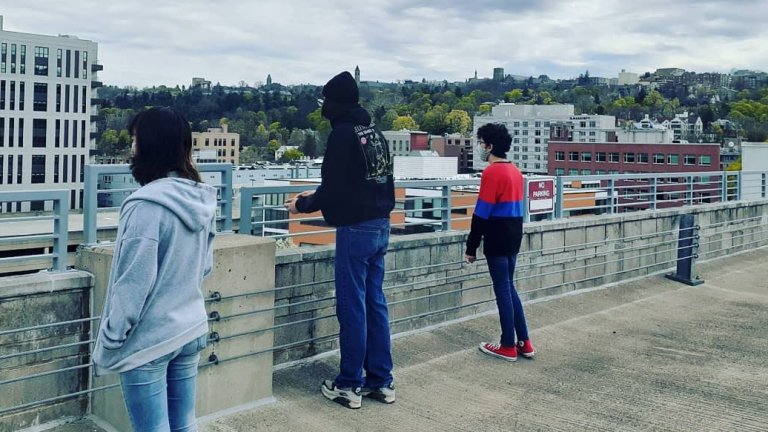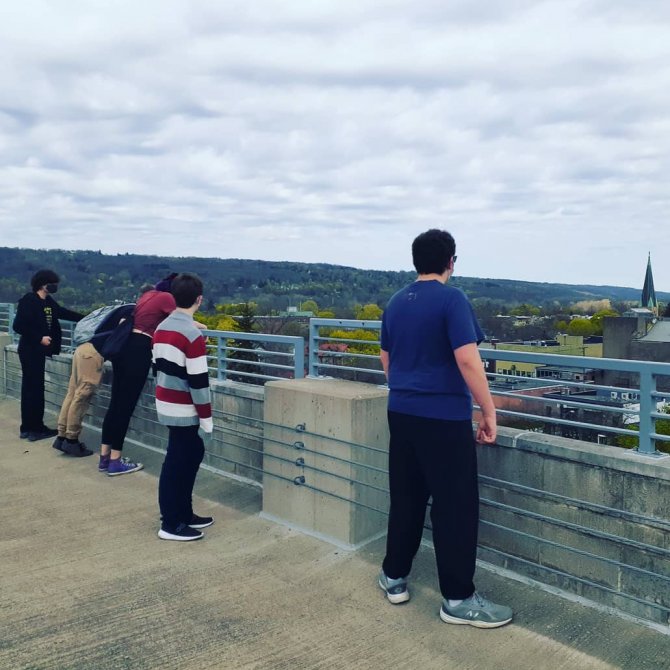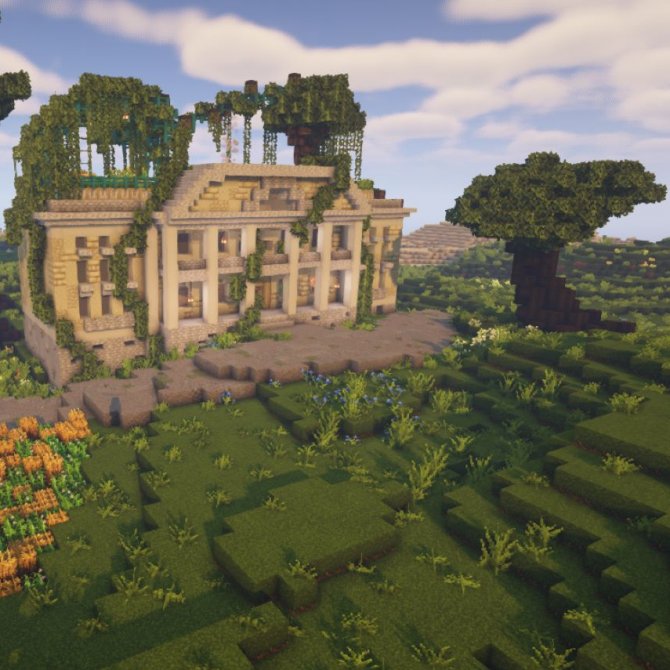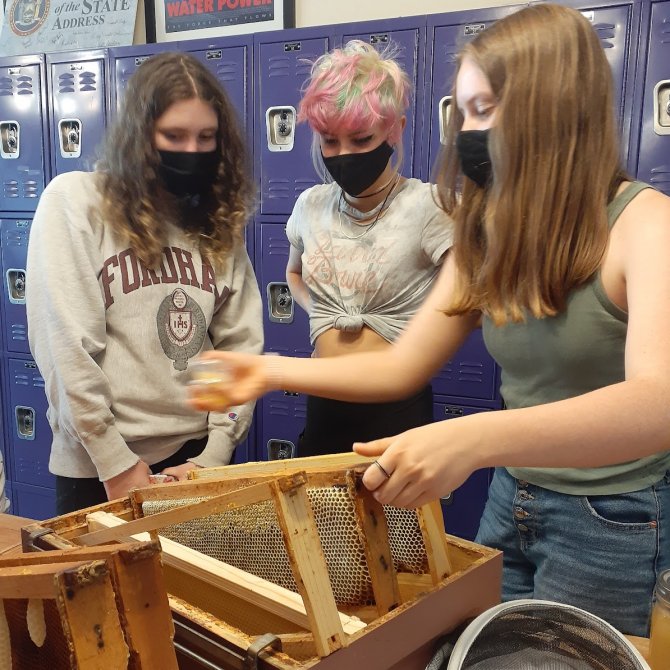
School Context
Now in our thirteenth year, New Roots Charter School in Ithaca, NY is a regional high school for young people in grades 9-12 designed as a whole-school model of education for sustainability. Recognized for our ground-breaking work as an Accelerator school in the Green Schools National Network, New Roots was designated a U.S. Department of Education Green Ribbon School in 2021. New Roots seeks to empower young people as citizens and entrepreneurs to create just, democratic communities, and thriving green economies that restore the natural world that sustains us. Excelling in both traditional and innovative curriculum areas, our students learn actively, think critically, and solve problems creatively and collaboratively, developing the knowledge and skills to redesign our communities for social, economic, and ecological sustainability. We support all students in defining and realizing their goals and aspirations, and in recognizing their ability to take leadership in improving the lives of their families and community. We put the best available tools – and the power of informed optimism – in the hands of tomorrow’s leaders.
Curricular Context
Our four-year curriculum scope and sequence is designed to integrate Education for a Sustainable Future (EfS) standards in every course, with place-based sustainability themes at each grade level. The academic program is organized into two “schools”: lower school (grades nine and ten) and upper school (grades eleven and twelve). The core subject classes that all lower school students are required to take are English, Global studies, Earth Systems Science (ESS), and math classes such as Algebra and Geometry. Students also have the additional classes of crew (New Roots’ advisory course), Spanish, Personal Wellness, and electives such as African drumming, urban hiking, and studio art. In grade 9, students explore the relationship between human and natural systems through place-based explorations of water and food production, and in grade 10, they focus on the theme of Being an Agent of Change, an EfS standard that is emphasized in their study of 20th century global history. The Solarpunk anchor project builds on the “agents of change” theme, using this literary genre that envisions a post-apocalyptic world in which humans live in harmony with nature and use technology in positive and productive ways. This project is primarily rooted in English class, with supporting activities in Earth Systems Science and crew.
This project profile is developed by Danielle Angie and colleagues at New Roots Charter School, working in partnership with Common Ground's Schoolyards Program and Teaching Our Cities
Environment

New Roots is located in downtown Ithaca, NY. We are housed in The Clinton House, an historic hotel built in the early 1800s. We have the unique situation of being a green school in a dense urban setting, with not even a patch of lawn on school grounds. This setting has been one of our biggest challenges, as well as a unique opportunity. Luckily, we were given the use of a small green space behind our building on an adjacent property to create our very own urban farm last year, and we have created a container garden on our expansive front porch. We are also fortunate that we have the entire city of Ithaca as our classroom. There are incredible resources within walking distance such as our local library, city hall, Southside Community Center, and our local history center, as well as gorges, waterfalls, Cayuga Lake and the creeks that flow into it. With the combined social resources that we have downtown, and the natural beauty and abundant waterways within walking distance on the outskirts of downtown, our natural and social assets outnumber our challenges.
Through New Roots’ Solarpunk project, students help to envision and enact a more sustainable Ithaca. By the time New Roots students dive into this project, they have already spent six months (or more) exploring downtown Ithaca through fieldwork connected to their core classes. From the moment the Solarpunk project kicks off, it challenges students to look at their city through the fresh lens of Solarpunk. Early on, students spend a day in English class walking around and viewing the city through this new lens. Where did they see solar panels? Were there any vertical gardens? What about urban beekeepers or farms? What they find is that Ithaca could be much more Solarpunk – a perfect launch point for students to become actors and agents of change in building a more sustainable city.
Expectations
Solarpunk is an emerging literary and artistic genre, and a creative movement. It envisions how the future might look if humanity succeeded in solving major contemporary challenges – with an emphasis on humanity integrated with nature, where technology is used for human-centric and eco-centric purposes. Renewable energy, vertical and urban gardening and beekeeping, caring for your communities, eco-friendly fashion, re-purposing and repairing objects, and art and writing incorporating these themes are all Solarpunk.
Throughout the Solarpunk project, students explore a big guiding question: What is Solarpunk and how does it relate to sustainability? To develop full answers to this question, students do more than just analyze and critique Solarpunk writing and artwork – they become contributors to this emerging genre and movement, creating artwork, artifacts, and real-world contributions to their city. The main learning targets for students’ work in the project reflects this focus on contribution and changemaking:
- I can re-envision Ithaca as a Solarpunk “green” city through artwork.
- I can learn about the importance of bees for the ecosystem and food production. I can plant and cultivate a pollinator garden as a “solutionary” practice to help increase the bee population locally.
- I can use my understanding of Solarpunk to create an artifact that contributes to this emerging genre in a meaningful way.
To date, the Solarpunk project has mostly lived in English class, with a focus on literature, research, writing, art, and design. A goal of incorporating math and science into Solarpunk in future years is to make the unit more interdisciplinary with a focus on how ecosystems function and change over time. There is also a vision for incorporating theater and performance into this curriculum in the coming years. In addition to the work that students do with Solarpunk directly (which also included learning about fast vs. Solarpunk fashion, reading Solarpunk fiction, and exploring Solarpunk aesthetics), lower school students learn about the phenomenon of bee colony collapse and planted a front porch pollinator garden, which included refinishing a bench for the garden (a student-led idea!).
The SolarPunk project is part of a bigger, school-wide commitment to Education for Sustainability (EfS). At New Roots, we follow a four-year scope and sequence based on the EfS applied knowledge domains, adopted from The Cloud Institute for Sustainability Education Benchmarks. These applied knowledge domains focus on “what” we are learning that can be understood, applied, and explained to others. The EfS standards Inventing the Future and Natural Laws and Ecological Principles are the two main domains students explore through their study of Solarpunk. These EfS standards are a strong match for this project: Solarpunk is a genre that literally looks towards the sustainable future we want to invent today and teaches us how to incorporate natural laws and ecological principles into creating a world where technology works with nature, not against it.
One of the aims of exploring the Solarpunk genre in tenth grade is to give students a hopeful, creative way to be agents of change. Solarpunk brings a vision of beauty and hope to our world. This topic allows students to learn about real-world sustainability measures that are being implemented right now and envisions a utopian future where life – humans, animals, and plants – thrive. It’s the perfect springboard for tenth graders to be more grounded in their EfS practice and vision of a sustainable future as they transition into eleventh grade, where they take a deeper dive into real-life sustainability issues such as working with local officials to learn about important initiatives such as the Green New Deal recently adopted by the City of Ithaca.
Exhibition

Throughout this unit, students have the opportunity to create real work for real audiences.
Early in the unit, students use artwork to re-envision their city – applying their own creativity and their growing understanding of Solarpunk design to the community they call home. The work they produce is varied – some created using traditional media, some with online modeling tools – but all demonstrate an understanding of students’ home places, urban design, and growing artistic skills.
Students’ most significant product for this unit is an original work, drawing on what they’ve learned about Solarpunk, and making a lasting contribution to this genre. Some examples of students’ Solarpunk-based artifacts include: creative fiction, Solarpunk fashion design, informational presentations about renewable energy and environmental impacts of current ways of living, artwork depicting a Solarpunk future, and jewelry-making using repurposed materials. Through their selection and creation of these products of learning, students deepened their understanding of not only the elements that make Solarpunk a genre that combines sustainability with verdant aesthetics, but real-world problems (such as the environmental destruction caused by fast fashion), and their solutions (like repurposing clothing).
Students' work has an immediate public audience and a lasting home. Students share their original works, and their artistic representations of a Solarpunk Ithaca, at a Solarpunk Showcase in which students for the wider school community. Their work also finds a lasting home as part of the New Roots Solarpunk Anthology, a collection of student work that began years ago. By creating and contributing an artifact to the anthology, students met the learning target of adding to this emerging genre in a meaningful way.
The unit also culminated with our beautiful front porch garden, which is the product that most impacts our urban environment. Not only does the garden benefit pollinators, such as honeybees; it creates green space for our school and beautifies Cayuga St, where New Roots is located. By planting a pollinator garden and restoring a bench for students to use in the garden, students truly experience Solarpunk action first hand, and apply their learning to transform a part of our school and our city.
Experience

We start this project by exploring the genre of Solarpunk. Students dissect the word itself to gain some clues, then we looked at a slideshow that featured Solarpunk artwork and real-life cities. After this initial exploration, students view an informational film about the genre. Students also read and view past artifacts from our school’s Solarpunk anthology and read fiction from the genre. They then apply this growing knowledge through the field experience described earlier: They head out into the City of Ithaca, looking for evidence of Solarpunk in the here and now. As each step of this exploration, we use exit tickets to assess student understanding of the genre, prior to their final performance task.
As they start work on the pollinator garden, students come to understand the “need to know” by exploring and writing about a cartoon that illustrated the phenomenon of bee colony collapse. From there, a Know-Want to Know-Learn (KWL) activity -- largely led by students -- helps them drive their own learning about the phenomenon of bee colony collapse and the implications that has on our ecosystem and food systems. Students learned more about bees through research, reading, and videos, and how to help them from the expert presentation they participated in with a local beekeeper and bee expert.
As part of the unit, students have the opportunity to connect with and learn from several anchor community experts – including a New Roots alumnus, two parents of students, and their neighbors in Ithaca:
- The Director of Bike Walk Tompkins, a local organization focused on making Ithaca more pedestrian and biker friendly
- Two experts in the solar industry, including a New Roots alum now working in California.
- A local beekeeper who brought in an observation hive, beekeeping gear, as well as honeycomb and various honey for students to sample (also the mother of New Roots students)
- A local furniture restoration expert, who guided students in the process of restoring an old, broken bench, start to finish (also the mother of a New Roots student)
- Members of Ecovillage (students toured this intentional community to learn about farming, gardening, pollinator-friendly plants, and green building design)
They also explore several anchor texts to deepen their understanding of the genre, and build skills as readers and writers:
- Wings of Renewal: A Solarpunk Dragon Anthology by Claudie Arseneault
- Informational Articles: Urban Architecture: Before and After, The Bloom of Vertical Gardens, Vertical Gardens: When Cities go Green and Grow up to the Sky
- “Asters and Goldenrod” from Braiding Sweetgrass by Robin Wall Kimmerer
While exploring and building background knowledge -- learning about pollination, bees, working on our pollinator garden, and learning more about urban farming, fast fashion, etc. -- students also use class time to work on their final Solarpunk projects and practice for their culminating Solarpunk Showcase.
Reflections
Overall, students enjoyed and found meaning in many aspects of this unit. Many students appreciated that they got to choose their own topic and style of exhibition; the majority of students either made artwork or wrote creative fiction.
On the other hand, some students didn’t really like the genre of Solarpunk. In the future, it might be beneficial to contrast the Solarpunk genre with another to provide students with multiple perspectives when it comes to envisioning a sustainable future .A goal for next year is to deepen and expand the anchor texts for this unit by including Octavia Butler’s Parable of the Sower and the film Black Panther – incorporating Afrofuturist voices that we believe will resonate with our students.
Sometimes, efforts to put sustainable designs into action don’t succeed on the first try. For instance, we attempted to create a “vertical garden” as part of our front porch garden, but the beans we planted did not do well. Hopefully, we can do more research for next year and successfully implement this gardening design in the futre.
For next year, there is the possibility of taking student ideas for transforming Ithaca into a Solarpunk city to our city council. However, there is also the desire to keep this unit in the creative and visionary realm, rather than pushing too much toward the realities of politics and policy. Regardless, as a team, we would like strengthen interdisciplinary connections by incorporating corporate additional math and science content.
